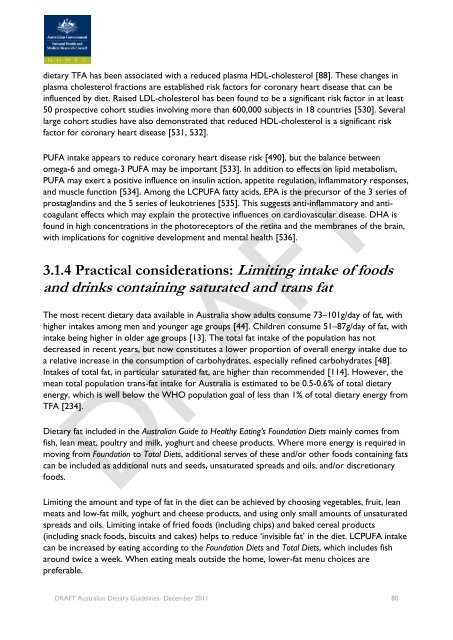DRAFT Australian Dietary Guidelines - Eat For Health
DRAFT Australian Dietary Guidelines - Eat For Health
DRAFT Australian Dietary Guidelines - Eat For Health
Create successful ePaper yourself
Turn your PDF publications into a flip-book with our unique Google optimized e-Paper software.
dietary TFA has been associated with a reduced plasma HDL-cholesterol [88]. These changes in<br />
plasma cholesterol fractions are established risk factors for coronary heart disease that can be<br />
influenced by diet. Raised LDL-cholesterol has been found to be a significant risk factor in at least<br />
50 prospective cohort studies involving more than 600,000 subjects in 18 countries [530]. Several<br />
large cohort studies have also demonstrated that reduced HDL-cholesterol is a significant risk<br />
factor for coronary heart disease [531, 532].<br />
PUFA intake appears to reduce coronary heart disease risk [490], but the balance between<br />
omega-6 and omega-3 PUFA may be important [533]. In addition to effects on lipid metabolism,<br />
PUFA may exert a positive influence on insulin action, appetite regulation, inflammatory responses,<br />
and muscle function [534]. Among the LCPUFA fatty acids, EPA is the precursor of the 3 series of<br />
prostaglandins and the 5 series of leukotrienes [535]. This suggests anti-inflammatory and anticoagulant<br />
effects which may explain the protective influences on cardiovascular disease. DHA is<br />
found in high concentrations in the photoreceptors of the retina and the membranes of the brain,<br />
with implications for cognitive development and mental health [536].<br />
3.1.4 Practical considerations: Limiting intake of foods<br />
and drinks containing saturated and trans fat<br />
The most recent dietary data available in Australia show adults consume 73–101g/day of fat, with<br />
higher intakes among men and younger age groups [44]. Children consume 51–87g/day of fat, with<br />
intake being higher in older age groups [13]. The total fat intake of the population has not<br />
decreased in recent years, but now constitutes a lower proportion of overall energy intake due to<br />
a relative increase in the consumption of carbohydrates, especially refined carbohydrates [48].<br />
Intakes of total fat, in particular saturated fat, are higher than recommended [114]. However, the<br />
mean total population trans-fat intake for Australia is estimated to be 0.5-0.6% of total dietary<br />
energy, which is well below the WHO population goal of less than 1% of total dietary energy from<br />
TFA [234].<br />
<strong>Dietary</strong> fat included in the <strong>Australian</strong> Guide to <strong>Health</strong>y <strong>Eat</strong>ing’s Foundation Diets mainly comes from<br />
fish, lean meat, poultry and milk, yoghurt and cheese products. Where more energy is required in<br />
moving from Foundation to Total Diets, additional serves of these and/or other foods containing fats<br />
can be included as additional nuts and seeds, unsaturated spreads and oils, and/or discretionary<br />
foods.<br />
Limiting the amount and type of fat in the diet can be achieved by choosing vegetables, fruit, lean<br />
meats and low-fat milk, yoghurt and cheese products, and using only small amounts of unsaturated<br />
spreads and oils. Limiting intake of fried foods (including chips) and baked cereal products<br />
(including snack foods, biscuits and cakes) helps to reduce ‘invisible fat’ in the diet. LCPUFA intake<br />
can be increased by eating according to the Foundation Diets and Total Diets, which includes fish<br />
around twice a week. When eating meals outside the home, lower-fat menu choices are<br />
preferable.<br />
<strong>DRAFT</strong> <strong>Australian</strong> <strong>Dietary</strong> <strong>Guidelines</strong>- December 2011 80

















